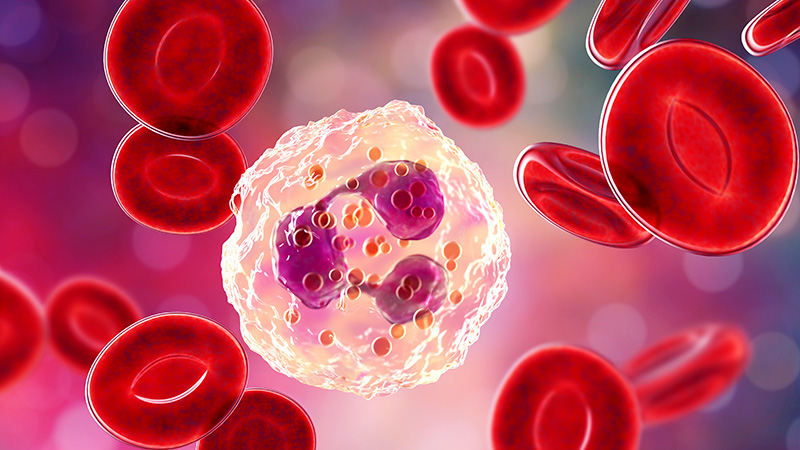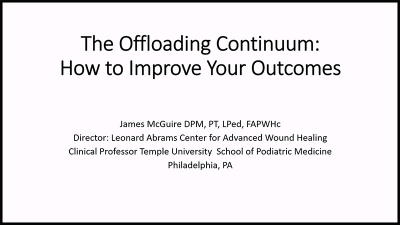
Practice Perfect 845
Postoperative Leukocytosis
A Common but Unreliable Indicator of Infection
Postoperative Leukocytosis
A Common but Unreliable Indicator of Infection

In medicine, we are surrounded by concepts and words, a sea of phrases, each with important meanings that have significant ramifications for our patients. Some of the more fundamental words that we learn at the beginning of our training are the cells involved in the complete blood count. For the podiatrist, perhaps the most important of these is the leukocyte, especially the neutrophil. For many of the patients we see in the hospital, a large number of these leukocytes in someone's blood count typically indicate infections. Most of the time, we improve infection either by giving antimicrobials or performing surgical procedures to eliminate the infection. We expect to see rapid improvement in the indicators of infection, most commonly a decrease in fever and a declining leukocytosis. However, it is also common to see these levels rise after surgery, a somewhat vexing situation. Is postoperative leukocytosis something to be concerned about? Or is there a more nuanced way to interpret these test results? Let's take a look at postoperative leukocytosis.
Is postoperative leukocytosis something to be concerned about or is there a more nuanced way to interpret these test results?
As a lover of medical history, I cannot help but point out that we use so many of these words, such as fever and leukocytosis, never thinking about those who came before. To that end, let's take a quick digression into medical history. The first description of the leucocyte was made in 1865 by Max Johann Sigismund Schultze. Schultze was a German microscopist who first described the four different types of white blood cells, the lymphocyte, monocyte, eosinophil, and neutrophil . Schultze was a contemporary of the great Rudolph Virchow, himself the father of cellular pathology, and I cannot help but imagine that these two scientists may have interacted in some way. At this time in history, German medical science was at its peak, and, considering the date, so much was happening in the world, including our American Civil War. We often learn about this time in history in the United States as if nothing else was happening. How egocentric of us. During this tragic time in our history, humanity was also making great medical strides. It was actually this time period that began the amazing upward trend of modern medical science that we currently enjoy. So many years later Schultze is just a name in history while his leucocyte lives on, examined so many times every day all over the world. We should all be so lucky to have such an epitaph.
It's outside the scope of this editorial to talk about the history and significance of fever, but for those of you interested, I refer you to Practice Perfect 706 about the characterization of fever by Carl Reinhold August Wunderlich and its clinical significance. I also cannot help but plug my own discussion about the Rule of I's for postoperative fever, which is, I think, a better mnemonic than the rule of W's. This is discussed in Practice Perfect 716. It is sufficient to say that the thermal regulatory setpoint is elevated in the immediate postoperative period leading to a physiologic postop fever, an indicator of perioperative stress2.
With those digressions in mind, let's talk more about Schultze's leukocyte and its significance after surgery. Is it normal for a patient to experience an increase in leukocytes after surgery?
Is it normal for a patient to experience an increase in leukocytes after surgery?
The vast majority of research studies show that postoperative leukocytosis is physiologic and not an indicator of infection. These research studies covered surgeries from several body areas including maxillofacial, cardiovascular, tonsillectomy, nephrolithotomy, traumatic splenectomy, and orthopedic procedures, specifically total hip and knee arthroplasty3-8. One commonality with these studies was the significance of the two-day timeframe at which one may expect postoperative Leukocytosis but after which it was an indicator of infection. Essentially, if you see an increase in the total leukocyte count after day 2 it was more likely to be caused by infection than physiologic postoperative stress. Additionally, there was a trend in these studies toward lower than 15,000 cells/microliter within that two-day period as being normal.
If you see an increase in the total leukocyte count after day 2, it was more likely to be caused by infection than physiologic postoperative stress.
An important point to make is that all these studies were in patients who underwent surgery for non-infection-related issues. For the practicing podiatrist this makes generalizing the results a little difficult. For a patient undergoing an elective surgical procedure such as an ankle fusion, we can apply these rules. However, for a patient admitted to the hospital for an acute infection, it is more challenging to simply state that leukocytosis after an amputation or an incision and drainage procedure is due only to physiologic stress. This is an area that needs more study. From a level 5, personal experience standpoint, I commonly see patients with postoperative leukocytosis after emergent surgery within the first two days in which the leukocytosis appears to be physiologic and quickly decreases within 2 days.
An interesting and related study by Fleischer and colleagues found that a persistent leukocytosis after three days was “the single most important marker for predicting a poor clinical response” in patients with severe diabetic foot infections9. This makes perfect sense considering the other studies that found leukocytosis to be normal within the first two days after surgery but abnormal after that. Fleischer’s study lends evidence to the significance of leukocytosis after two days as an indicator of continued infection.
What is the cause of this postoperative leukocytosis that is physiologically normal? Ascione and colleagues found an increase in interleukin-8 and complement, specifically C3a and C5a, in patients after coronary artery bypass surgery10.
Given these studies, a fair rule of thumb is to consider a total lymphocyte count of 15,000 cells/microliter within 2-days of surgery as a cytokine-induced physiological response to stress and not infection. After that time period, infection should be carefully considered.
Consider a total lymphocyte count of 15,000 cells/microliter within 2-days of surgery as a cytokine-induced physiological response to stress and not infection. After that time period, infection should be carefully considered.
Best wishes.

Jarrod Shapiro, DPM
PRESENT Practice Perfect Editor
[email protected]

-
Cavaillon JM. The historical milestones in the understanding of leukocyte biology initiated by Elie Metchnikoff Leukoc Biol. 2011 Sep;90(3):413-424.
Follow this link -
Frank SM, Kluger MJ, Kunkel SL. Elevated thermostatic setpoint in postoperative patients. Anesthesiology. 2000;93(6):1426-1431.
Follow this link -
Czaplicki AP, Borger JE, Politi JR, Chambers BT, Taylor BC. Evaluation of postoperative fever and leukocytosis in patients after total hip and knee arthroplasty. J Arthroplasty. 2011 Dec;26(8):1387-1389.
Follow this link -
Foote JA, Selinger M. POSTOPERATIVE LEUKOCYTOSIS AND TEMPERATURE VARIATIONS FOLLOWING TONSILLECTOMY: AN ANALYSIS OF 147 CASES ARRANGED IN FOUR AGE GROUPS. Am J Dis Child. 1927;33(1):96-104.
Follow this link -
Al-Shayyab MH, Al-Omiri MK, Ryalat S, Qabbaah K, Baqain ZH. Leukocytosis is common after orthognathic surgery: A retrospective study. Ann Neurosci. 2013 Oct;20(4):155-156.
Follow this link -
Deirmengian GK, Zmistowski B, Jacovides C, O’Neil J, Parvizi J. Leukocytosis is common after total hip and knee arthroplasty. Clin Orthop Relat Res. 2011 Nov;469(11):3031-3036.
Follow this link -
Bozkurt IH, Aydogdu O, Yonguc T, Koras O, Sen V, Yarimoglu S, Degirmenci T. Predictive Value of Leukocytosis for Infectious Complications After Percutaneous Nephrolithotomy. Urology. 2015 Jul;86(1):25-29.
Follow this link -
Bell DM, Goldmann DA, Hopkins CC, Karchmer AW, Moellering Jr RC. Unreliability of fever and leukocytosis in the diagnosis of infection after cardiac valve surgery. J Thorac Cardiovasc Surg. 1978 Jan;75(1):87-90.
Follow this link -
Fleischer AE, Wrobel JS, Leonards A, Berg S, Evans DP, Baron RL, Armstrong DG. Post-treatment leukocytosis predicts an unfavorable clinical response in patients with moderate to severe diabetic foot infections. J Foot Ankle Surg. 2011 Sep-Oct;50(5):541-546.
Follow this link -
Ascione R, Lloyd CT, Underwood MJ, Lotto AA, Pitsis AA, Angelini GD. Inflammatory response after coronary revascularization with or without cardiopulmonary bypass. Ann Thorac Surg. 2000 Apr;69(4):1198-1204.
Follow this link
































Comments
There are 0 comments for this article